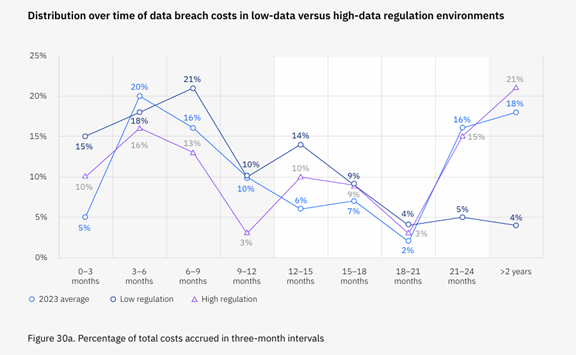
In the digital age, data is the lifeblood of businesses. It fuels operations, decision-making, and customer interactions. However, the persistent threat of data breaches plagues our data-driven industries.
The frequency and sophistication of cyber threats continue to rise. Proactive cybersecurity measures are not just a necessity. They are a strategic imperative for safeguarding the long-term success of businesses.
The repercussions of a data breach extend far beyond the immediate aftermath. They often haunt businesses for years. Only 51% of data breach costs occur within the first year of an incident. The other 49% occur in year two and beyond.

Image source: IBM's Cost of a Data Breach Report 2023
A single breach can impact a business's reputation, finances, and regulatory standing.
WEBIT Services has over 25 years of experience helping clients in the greater Chicago area achieve their IT goals.
By reading this article, you will learn the long-term consequences of a data breach.
5 Unseen Costs of a Data Breach
1. Financial Repercussions
The financial toll of a data breach is significant. Immediate costs include things like:
- Breach detection
- Containment
- Customer notification
Beyond those, businesses face long-term expenses. These relate to legal battles, regulatory fines, and reparations.
Regulatory penalties are just one facet of the financial repercussions. Others include potential legal actions from affected individuals and class-action lawsuits.
2. Reputation Damage
The impact on a business's reputation is arguably the most enduring consequence. Customers lose trust in a company's ability to protect their sensitive information. This loss of confidence can result in declining customer retention, acquisition difficulties, and long-lasting damage to the brand image.
Rebuilding a tarnished reputation takes time and concerted efforts. These may involve public relations campaigns and enhanced security measures to help assure stakeholders of renewed commitment to data protection.
3. Regulatory Scrutiny
Regulatory bodies hold businesses accountable for safeguarding consumer data. A data breach triggers regulatory scrutiny, which may lead to fines and ongoing compliance requirements.
Regulatory authorities take a stringent stance on data security. They are very strict with companies that fail to meet cybersecurity standards. The fallout includes financial penalties, increased surveillance, and mandatory security improvements.
4. Operational Disruption
The aftermath of a data breach disrupts normal business operations. Companies must take remediation efforts and implement enhanced security measures, which can divert resources away from core business functions.
The company feels the impact across departments, affecting productivity and efficiency. The ripple effect of operational disruption can extend for years. The chaos and recovery from a breach impede growth and hinder the organization's ability to adapt to market changes.
5. Customer Churn and Acquisition Challenges
A data breach often leads to customer churn. Individuals lose confidence in the business's ability to protect their data.
Acquiring new customers becomes challenging. Potential clients are wary of associating with a brand that has suffered a breach.
The prolonged effects on customer acquisition can hinder the company's growth and its market competitiveness.
Next Steps to Preventing a Costly Data Breach
The repercussions of a data breach extend far beyond the immediate incident. They can impact a business's financial health, reputation, and regulatory standing for years.
The actual cost of a data breach is not always immediately evident. It's a complex interplay of things like:
- Financial penalties
- Reputation damage
- Regulatory consequences
- Operational disruption
These impacts can persist for years. Learning from real-world examples and focusing on robust cybersecurity measures is essential.
Solid IT security practices and IT incident response plans mitigate the risks associated with data breaches. They also safeguard a company's immediate interests and its long-term viability.
Consult your IT provider or internal IT team to discuss risks, cybersecurity practices, and an incident response plan.
If your current provider hasn't been proactive with risk assessments or incident response planning, it's a red flag. Consider finding a new provider to ensure better cybersecurity practices.
WEBIT Services is passionate about cybersecurity practices and education. It sees knowledge and awareness as the first step in developing effective cybersecurity procedures.
If you are looking for a new IT provider, schedule a free 30-minute consultation to see if WEBIT can help.
If you're not ready to make a commitment but would like to learn more about cybersecurity, we recommend the following articles:


